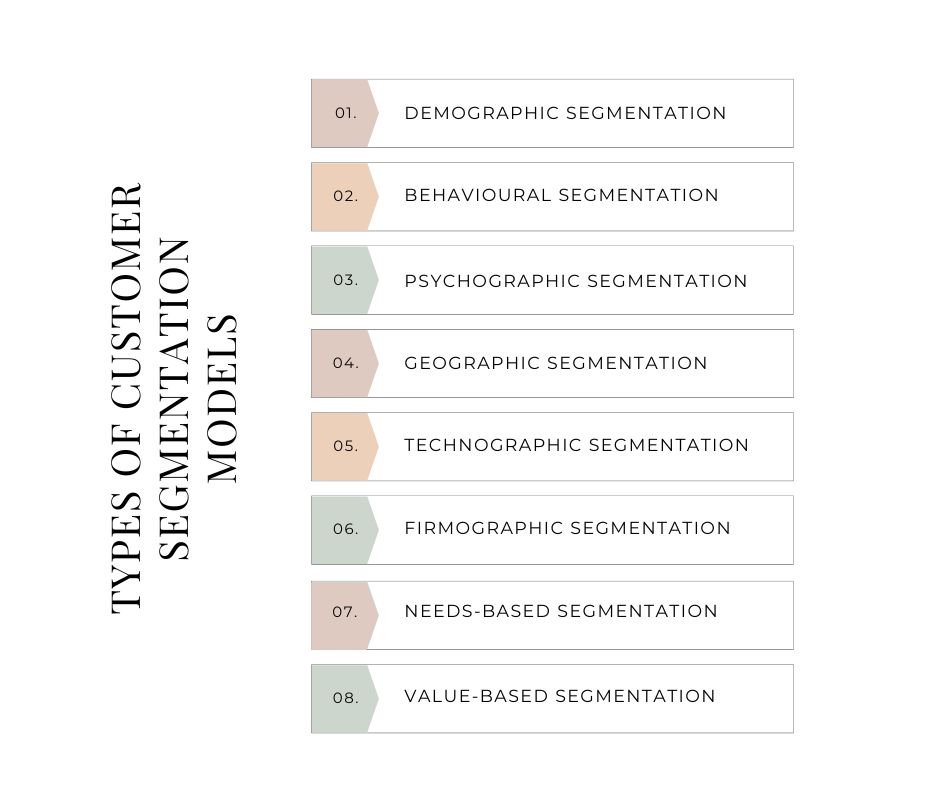In the current business world, it’s important to get to know your customers & personalize your marketing plans according to their wants and needs. Doing this can be what helps you stand out from the competition & achieve success. One awesome and effective approach to achieving this is through customer segmentation models. Companies can use these models to divide their customers into smaller groups based on similar traits and then create marketing plans specifically designed for each segment. This not only helps them reach their desired target audience accurately but also boosts their overall ROI. Check out this article to know and learn more about customer segmentation models and the advantages they can bring to your business. We will also be talking about how to pick the ideal ones for your brand.
What is a Customer Segmentation Model?
Customer segmentation is when customers are divided into smaller groups based on their characteristics. Doing this can help you understand their actions, likes & dislikes, and necessities better. It’s important to get to know your customer groups and their individual wants & needs. This way, you can craft custom marketing campaigns that suit everyone, ultimately leading to better results.
Read about: asset utilisation analysis
Customer Segmentation Analysis
Once you identify and categorize your customers, it’s vital to keep studying & analyzing them on an ongoing basis. This can help you see and determine which segments are most important for attaining your business goals and make decisions based on actual data. Segmentation of your customers can give you a clearer picture of who you’re targeting with your resources. It also assists you in getting customer feedback and focuses on building relationships for the long term.
Benefits of Analyzing Your Customer Segmentation
It may take some time to do customer segmentation, but it’s really worth it in the end. You can get lots of advantages for your business by doing the following:
- More Customer Retention: Building those one-on-one connections helps you make happy customers who stick around. Plus, you can tailor your messages based on where they’re at in their customer journey.
- Enhances Competitiveness: Knowing the right way to segment your customer base and using your marketing bucks efficiently can give you a leg up on the competition. Segmenting takes out the guesswork, so you can get an in-depth understanding of customers and target them properly like a pro.
- Establishes Brand Identity: Once you’ve figured out what makes your customers tick—whether it’s killer design, affordable prices, or meeting their unique needs—you can brand your products in a way that’s totally on point. By segmenting your customers, you’ll make sure they’re all about your brand.
- Better Customer Relationship: Breaking down your customer base can be really helpful in targeting campaigns and messages to the right people. Not only this, but it also helps build a stronger connection with customers as they feel like their voice is being heard and acknowledged.
- Leads to Price Optimization: If you want to build a strong customer base, then pricing your products correctly is essential. You should try and create the right balance between what your customers can afford and the value they see in it. That’s what we call price optimization, and it’s key for creating customer loyalty.
- Best Economies of Scale: Even with limited resources, you can still get a lot accomplished. Try segmenting your customers and focusing on them to get the most out of your hard-worked efforts. This way, you can reach your goals much faster & more effectively without spending too much money.
- Improves Channel of Distribution: Go where your customers go at the right time. Customer segmentation helps you figure out where your customers shop and when. Armed with this knowledge, you can strategically distribute your products and eliminate any confusion about who should get them and when.
- It Allows You to Fine-Tune Your Message: By segmenting your customers, you can precisely target who you are aiming for. You can also create a message that captures their attention and transforms them into passionate fans. It’s like mastering the art of persuasion!
- Increases Your Revenue: Grouping your customers can lead to finding a new target market segment. This could potentially change up your marketing plans, resulting in more sales and bigger profits.
- Increase Brand Awareness: Customizing your marketing messages for each customer makes them feel special and closer to your business. This enhances customer loyalty & strengthens your brand’s image in the market. Your customers won’t just be a name on a mailing list. They’ll be your biggest fans.
Read about : advantages of customer segmentation
How to Do Customer Segmentation Analysis
Doing customer segmentation analysis isn’t too tricky if you know where to start. Here’s how to do it:

1. Review customer segments for accuracy:
It’s a must to ensure that your customer segments remain accurate and up-to-date. Doing so can help you reach the right customers and deliver more effective campaigns across multiple channels. Don’t forget to keep your segmentation data up-to-date by regularly reviewing and refining it so that it reflects any recent changes in customer behaviour or other important factors. That way, you can then make sure that your info is accurate.
2. Compare customer segment performance against business goals:
Evaluating your business performance is key, and it’s important to look at the KPIs in different areas. This can help you study and understand how well your business is doing. Studying your KPIs helps you see exactly which parts of your business are seeing the most success. With this insight, you can figure out where to focus the bulk of your resources and can adjust strategies for better results.
3. Check with internal teams for segmentation feedback:
Get input from the right people inside your organization to make sure that your segmentation matches up with their thoughts and requirements. Keeping everyone on the same page encourages collaboration and ensures that segmentation is used consistently.
Read about: Ultimate Guide To “Businesses Owned By Amazon
4. Collect feedback from your customers:
Keep tabs on your customers by getting their opinions. You could find out about their experiences and expectations through email surveys, feedback forms, focus groups and social media. That way, you’ll be better prepared to meet their needs. Below are the many different ways you can get what you’re customers really think about your business/brand/products/services:
5. Website feedback widgets:
Want to hear what customers think? Put up some widgets on your site, like banners or pop-ups. This is a rad way to get feedback from them – people can give their opinion and rate their experience while they’re on your website.
6. Long form-based surveys:
To get a better understanding of your customers, creating surveys with multiple questions is a great idea. You can either email them out or make them accessible on your website. Just make sure it’s long enough to give you valuable feedback but not so long that people won’t actually fill it out!
7. Suggestion boards:
An online suggestion board or forum can be an excellent way for customers to engage with your brand. They can share ideas, suggestions and feedback, helping you make improvements and also giving you valuable insight.
8. Newsletter requests:
In your email newsletters, have a space set aside for subscribers (or ask them) to give feedback or ideas. This way, you can collect insights from those who already are invested in your brand and pay attention to what you’re sending. Plus, it’s great for gaining more insights from your existing customer base.
9. Survey incentives:
Make customers feel appreciated by offering incentives when they fill out surveys. This can be in the form of discounts, offers, coupons or even entry into a prize draw. This will reward them for taking the time to give feedback and increase survey response rates.
10. Live chat prompts:
If you have a live chat function on your website, it’s definitely worth using it to get direct customer feedback. Ask your chat agents to request reviews from customers during or after their conversations – this way, you can get immediate insight and address any potential issues quickly.
11. Social listening:
Keep an eye on social media and online communities – see what your customers are saying about your brand, their reviews, feedback, etc. This could be very helpful in spotting areas where you could make improvements.
12. Customer support outreach:
Don’t wait for customers to come back to you. No. Reach out to them after they’ve had contact with your customer support team. Follow up & ask them how their experience was, & take the time to resolve any and every (if possible) issue they may have encountered.
13. Put segmentation analysis results into action:
Once you’ve altered your customer segments, you should get to use them. You’ll probably need leadership’s assistance to train the staff and unify marketing and sales with the new segments.
Customer Segmentation Strategy
Figuring out how you’d like to divide up your customers into different groups is fundamental for getting the most out of segmentation. You should think about the following:

- Determine your customer segmentation goals and variables: Figuring out what it really is that your business wants to achieve and the factors you’ll consider when segmenting customers is key. If you’ve already got buyer personas in place, make sure those are part of the process. Plus, make sure you have the right data or grab more data to provide a great customer experience.
- Break goals into customer-centric segmentation projects: Break your goals into chunks that can be completed in a reasonable amount of time. Keep in mind that all objectives can’t be achieved immediately, so organize them and take one step at a time.
- Set up and prioritize each customer segmentation project: Get your projects sorted out by beginning with the biggest parts or ranking them according to performance (such as purchase value). This way, you can take advantage of quick chances and distribute resources skilfully.
- Collect and organize your customer data: Make sure you’ve got the data you need to form useful customer segments. Consider using surveys, social listening, tracking in-store traffic, and running contests to get valuable insights about your customers.
- Segment your customers into groups of your choosing: When dividing your customers into groups, make sure it’s easy to use for other people in the organization. When splitting up customers, make sure to keep these things in mind to get the best results:
- Make segments user-friendly: Make sure everyone in your team can understand & use your segments. Streamlining the segmenting process and having clear guidelines can help make it smoother.
- Utilize machine learning: ML methods can help you automate the customer segmenting process – saving time & effort for your team while also increasing accuracy.
- Ensure easy access: Make sure whatever segments you have to go with your marketing and sales channels, making it easier for everyone. This’ll make it much simpler to intertwine into your campaigns & customer engagement efforts.
- Establish stable segments: Make sure to create segments that will really stick & can be used in the long run. Try to use behavioural & psychographic data that won’t change too quickly, so your team can build strong relationships with customers over time & have meaningful connections.
- Focus on profitability: When it comes to your target audience, it’s important to prioritize those that will help you increase profits. Figure out who is most profitable and focus on them – this can make a huge difference in your bottom line.
- Understand model overlaps: Using behavioral and demographic models together gives you a better picture of who your customers are than using either one by itself. Knowing where these segments overlap can give you a deeper understanding of your customer base.
- Target & Market to Your Client and User Segments
Once you figure out who you’re targeting, it’s a must-do to get your message across to them. There are certain methods that can help – like using different marketing strategies for each segment. It’s worth taking a look at what’ll work best for who you’re trying to reach.
- Make communication customer-centric: Check out your segments and use the info to tailor your messages, content, etc., so that you can give each segment the best experience. Strategize in a way that not only grabs their attention but also fully comprehends what each one needs.
- Create a plan for each segment: Segmenting data is great for providing a better customer experience, personalizing communication, and making sure your leads are taken care of. You can also use it to optimize when you reach out, know what support people need, create content specifically designed with them in mind, and speed up resolving any issues.
- Run regular customer segmentation analysis: Regularly assess and review how your segments are doing. It’s important to keep up with customer trends since they’re always changing, which means you gotta stay on top of segment performance and make sure it still lines up with objectives.
What Are the Types of Customer Segmentation Models?
Splitting your customer base into smaller groups can be really beneficial for creating an effective marketing strategy. Digging through customer data and finding a model that works best with your business is the key to making segmentation successful. Demographic & psychographic models, for instance, can be used to target specific customers and help you get the most out of marketing investment.

Consider exploring these segmentation models to ensure you reach the right audience & maximize ROI:
- Demographic Segmentation: This one’s all about dividing customers based on stuff like income, education, gender, and age. Think of a car company aiming at fancy folks with fat wallets who crave luxury wheels.
- Behavioural Segmentation: Time to group customers based on their shopping habits and actions. It’s like when an online store targets the shopaholics who can’t resist a good deal and showers them with personalized recommendations.
- Psychographic Segmentation: This is where we dive into customers’ minds and uncover their personality traits, quirks, beliefs, and interests. Imagine a fitness brand going after health fanatics who are all about yoga, meditation, and finding their inner zen.
- Geographic Segmentation: Let’s consider where customers are located on the map. This one’s handy for businesses aiming to conquer specific regions or local markets. Picture a restaurant chain tailoring its marketing mojo to different cities or even specific neighborhoods.
- Technographic Segmentation: We’re talking about knowing customers’ tech preferences here – the gadgets, software, and platforms they can’t live without. It helps businesses tweak their digital strategies and connect with tech-savvy peeps who are always up for the latest tech trends.
- Firmographic Segmentation: This one is for B2B folks! It’s all about slicing and dicing customers based on their organizational deets like industry, company size, revenue, and location. This way, businesses can spot potential customers that perfectly match their business requirements.
- Needs-Based Segmentation: Let’s divide customers into groups based on their specific needs. It’s like offering tailored products, services, and marketing messages to address those needs head-on. Just think of a brand that caters to busy moms or fitness enthusiasts with customized solutions.
- Value-Based Segmentation: Time to focus on customers who bring home the bacon – the ones who contribute the most value to your business. Identify those high-value customers by looking at how frequently they purchase, how much they spend, and how long they stick around. Then give them the VIP treatment they deserve!
Questions to Ask to Find the Right Segmentation Model for Your Business
Breaking customers down into segments is still a major headache for many businesses. It’s complicated and time-consuming work trying to make sense of customer data to find patterns and trends so you can target the right people with your offerings. In order to pick the most ideal and suitable model for your business, it is a must to consider the following key questions:
1. What is your immediate goal?
Before you take any steps, figure out what you want to get out of this. Think about whether you want more sales, happier customers, market growth, or better products. Your end goal will help plan your segmentation process.
2. What’s the largest segment that will help you reach that goal?
Figure out the target market that fits your goals. For instance, if you’re trying to sell a specific product, think of the segment that would be most likely to need and buy it.
3. Who makes up that broad segment?
Get a good understanding of who makes up the bigger group. This will help you to narrow your segmentation and put together specific market tactics.
4. What is the best segmentation model for your goal?
Have a look at the various segmentation options available & pick the one that fits your purpose and target audience. Keep in mind that there’s no universal method here, so you may have to experiment a bit until you get it right.
Do you have the right tools to understand your consumers and evaluate the success of your segmentation model?
You need to make sure you’ve got the right analytics tools to help understand the impact of your online and offline campaigns. These instruments can track & measure how effective your segmentation strategy is.
Customer Segmentation Models in Action
A lot of businesses now use customer segmentation models to understand their audiences better and target them accordingly. Let’s dive into how different segmentation models help the real estate industry finds its ideal customers:
- Demographic Segmentation: Real estate companies can make use of demographic segmentation to target homeowners, prospective purchasers & those looking to relocate. They can run tailored marketing campaigns considering the individual needs & desires of each group.
- Behavioural Segmentation: Real estate agencies can now offer more tailored services to their customers by grouping them according to their behaviors and preferences. This could include identifying first-time homebuyers, investors, or folks wanting to rent a property which allows for sending out much more personalized messages and recommendations based on what they’ve done before.
- Psychographic Segmentation: Knowing what buyers want and understanding their psychology is essential for estate agents. It helps them figure out different groups like people looking for eco-friendly homes, luxury property seekers, or those who value living in a community-oriented neighborhood. Tailored marketing campaigns can be made to meet people’s individual needs and wants.
These examples show how customer segmentation can help you target and aim for the right people with your marketing campaigns and make sure you’re getting the most out of them.
Wrapping up:
Customer segmentation is undoubtedly an essential tool for any modern business. Companies are leveraging cutting-edge customer segmentation models to get a better understanding of their customers & create custom campaigns that deliver higher ROI. With the help of these models, companies can target specific customer segments with tailored messages, resulting in higher engagement and increased returns on investments.
When deciding on a model, you gotta take your time and evaluate the situation frequently while also being able to adjust according to customer needs. Doing this will help create a result-driven segmentation plan that brings maximum ROI.




